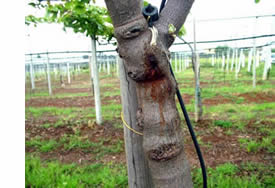
Expert Working Group for express PRA
on Pseudomonas syringae pv. actinidiae
(EPPO headquarters, Paris, 2011-09-05/08)
Bacterial canker of kiwifruit caused by Pseudomonas syringae pv. actinidiae was first noticed in the EPPO region in central Italy in 1992, where it remained sporadic and with no economic incidence for 16 years. However, in 2008 economic losses started to be observed, particularly in the Lazio region, and the possible spread of the disease to other kiwifruit producing regions in Italy began to raise concerns. Because P. syringae pv. actinidiae was an emerging disease in the Mediterranean region, the EPPO Secretariat decided to add it to the EPPO Alert List in 2009. In 2010 it was reported in France, Portugal, New Zealand and Chile; in 2011 in Spain, Switzerland and Australia. The Working Party on Phytosanitary Regulations in June 2011 considered that an express PRA should be conducted.
An Expert Working Group on P. syringae pv. actinidiae met in Paris on 2011-09-05/08 to develop an express PRA. The overall conclusion of the PRA was that measures should be implemented to prevent further spread in the region and ensure that planting material is free from the pest. The measures recommended by the EWG will be reviewed in the EPPO framework.

Courtesy: Plant Protection Service
of Emilia-Romagna region (IT)
Risk assessment
Risk of entry: high
The pest has already entered the PRA area; thus the risk of entry to new areas is high. Transfer of plants for planting (including tissue culture) represent the main pathway of entry to new areas as suggested in recent outbreak situations. Recently, pollen samples were tested positive and although it was acknowledged that this finding did not provide sufficient evidence to consider that infected pollen can spread the disease, the EWG considered the involvement of pollen in P. syringae pv. actinidiae transmission should not be excluded and measures should be identified.
Risk of establishment: high
The pest has already established in part of the PRA area. Climatic conditions are suitable in areas where kiwifruit orchards are present.
Impact: high
Impact is likely to be very high for the producers. In the countries of the EPPO region where the pest is present the disease is reported with a high incidence. In Italy, 4 years after the first reports several orchards show up to 80-90 % incidence on kiwi yellow cultivars. There are no curative treatments available (unlike in some other parts of the world antibiotic treatments are not authorized in many EPPO countries).
Risk management
The EWG decided to identify management measures by following the management part of the EPPO Decision Support Scheme for PRA. For plants for planting management measures identify include production of the plants in pest-free places of production or pest-free areas. Details on how pest-free place of production and pest-free areas can be established have been elaborated and will be reviewed by the EPPO Panel on Phytosanitary Measures.
For pollen (see entry for the uncertainty) similar measures have been identified (heat-treatment seems promising but no data is available on efficacy)
Other recommendations: surveys should be conducted in all kiwifruit growing countries and measures to be taken upon a finding of P. syringae pv. actinidiae in orchards have been proposed.
